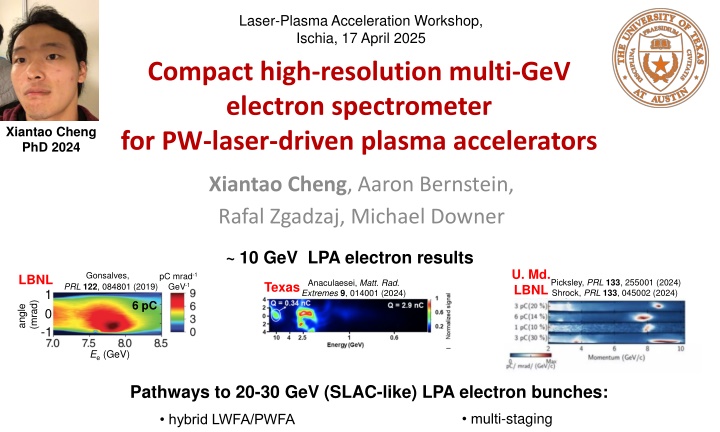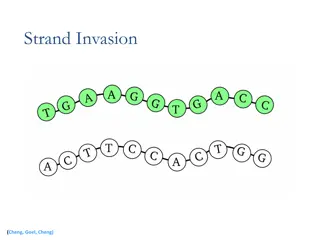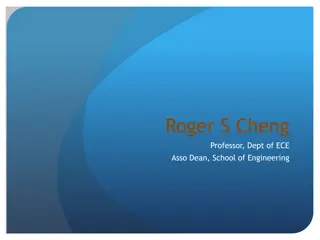
Advanced Techniques in High-Energy Electron Spectrometry
Explore cutting-edge methodologies and technologies in high-energy electron spectrometry, including compact high-resolution spectrometers, multi-meter magnetic e-spectrometers, and fiducial wire e-spectrometers. Learn about dual-screen magnetic spectrometers, equivalent magnetic fields, and quantifying measurement error for precise electron trajectory analysis in laser-plasma acceleration research.
Uploaded on | 0 Views
Download Presentation

Please find below an Image/Link to download the presentation.
The content on the website is provided AS IS for your information and personal use only. It may not be sold, licensed, or shared on other websites without obtaining consent from the author. If you encounter any issues during the download, it is possible that the publisher has removed the file from their server.
You are allowed to download the files provided on this website for personal or commercial use, subject to the condition that they are used lawfully. All files are the property of their respective owners.
The content on the website is provided AS IS for your information and personal use only. It may not be sold, licensed, or shared on other websites without obtaining consent from the author.
E N D
Presentation Transcript
Laser-Plasma Acceleration Workshop, Ischia, 17 April 2025 Compact high-resolution multi-GeV electron spectrometer for PW-laser-driven plasma accelerators Xiantao Cheng PhD 2024 Xiantao Cheng, Aaron Bernstein, Rafal Zgadzaj, Michael Downer ~ 10 GeV LPA electron results U. Md. LBNL Gonsalves, pC mrad-1 GeV-1 LBNL Picksley, PRL133, 255001 (2024) Shrock, PRL133, 045002 (2024) Anaculaesei, Matt. Rad. Extremes 9, 014001 (2024) Texas PRL122, 084801 (2019) 1 6 pC (mrad) angle 0 -1 Ee (GeV) Pathways to 20-30 GeV (SLAC-like) LPA electron bunches: multi-staging hybrid LWFA/PWFA
Multi-meter, multi-ton magnetic e-spectrometers compromise the unique virtues of LPAs: compactness low expense SLAC 30 GeV e-spectrometer 1
Dual-screen magnetic spectrometers help to deconvolve electron launch angle variations from energy variations... B. Pollock et al., Two-screen method for determining electron beam energy and deflection from laser wakefield acceleration, Particle Accelerator Conference (2009) Shape of peaks changes between screens. Resulting errors in electron energy determination increase rapidly for Ee 3 GeV. ...but are limited in accuracy because they rely on diffuse spectral features of the e-beam.
Fiducial wire e-spectrometer @ Texas PW Laser 1st prototype deployed: Wang et al., Nat. Commun. 4, 1988 (2013) compact ? = ?0+ ?1+ ?2 3? e-/X-ray source location: ?0 2 wire arrays ( ) 75 ? Fujifilm BAS IP 50 or 100 m pixels ?? 20 ? 150 J, 150 fs f/45 7 cm ?0= 1.1T 4 4cm ???0 .01 diameter: 127 m ?? ( ) 25 ?(ISO 2768 CNC machining precision) 0.1 ?-tron X-rays electron signal 1
Equivalent magnetic fields hasten energy analysis Errors ??, ?? from use of equivalent fields... ?0? = ? ? ?? ??= ?(?) ? ? ?? ?0 ? ? ? directly measured ? [cm] (??,??)* intra-magnet e- trajectories ? [GeV] ? [GeV] ...are negligible ? [cm] compared to contributions to ??, ?? from variances in: ?0 ???0 .01 (magnetic field) ?? ?? 20 ? (shadow positions) ( ) 75 ? (source location) * pivot point ( ) 25 ? (fiducial wire positions) 2
Quantifying measurement error Electron trajectory formulas: Error (??) in electron energy propagates from errors in 4 independent variables: 2 ?? 2 2 ??2 ?0 ?? ? ? ? magnetic field: ???0 .01 (Hall probe accuracy) shadow positions: ?? 20 ? ( IP pixel) fiducial wire positions: ?? 25 ? (CNC machin- ing precision) source position: ?0 75 ? (X-ray triangulation) 3
Measurement error contours (B?= 1.5 T) D=5 cm L=3 m D=5 cm L=3 m Such contours are essential for evaluating spectrometer designs for a specified energy range (E), space (L), and accuracy ( E/E). D=10 cm L=10 m D=10 cm L=10 m 4
Design of fiducial wires cylindrical (?-independent) diameter ~ pixel width (minimize ??) high Z (high-contrast shadow) GEANT4 simulations reveal energy-dependent shadow shapes: brightness at detector ????? (arb. units) Relative recorded Energy-dependent shape & contrast of wire shadows provide an independent (albeit coarse) e-spectrometer.
Everyday analysis of real data (Ex. 1) Step 1) examine raw data Ross filters for ?-tron X-ray spectrum analysis perfectly straight electron streak with E-independent width ?? ~ 1 mrad. Shadows e1-e9 on e-streak; X1 X6 on ?-tron X-rays. x [pixel no.] ~ 2 GeV
Everyday analysis of real data (Ex. 1) Step 2) X-ray triangulation of source location 1 mm IP shift row 1 shadows IP shifted ~1mm due to loose fit in holder. row 2 shadows ?-tron X-ray data from IP row 2 row 1 corrected for IP shift 500 0 z [mm]
Everyday analysis of real data (Ex. 1) Step 3) Reconstruction of launch angle ? ? and e-spectrum ??(?) ?? after correcting magnet position error. Energy-dependent ? ? , inconsistent with straight electron streak .
Ex. 2a: E > 3 GeV features + energy-dependent ? ? Anaculaesei et al. Acceleration of high-charge electron bunch to10 GeV ni a 10cm nanoparticle-assisted wakefield accelerator, Matt. Rad. Extremes 9, 014001 (2024) preliminary piece-wise analysis of features with different y deflections. ??(?) ?? comprehensive reconstruction > 3 GeV 8
Ex. 2b: Comparison with simulated dual-screen measurement E-beam from Ex. 2a, replicated in GEANT4, exposes 2 virtual screens. screen 1 screen 2 Reason for discrepancy: ??: electron energy obtained from fiducial wire analysis Peak locations determined jointly by ?(?) and ?. The mixture depends on screen location. Fiducial wire method is not subject to this ambiguity. 5% ???: electron energy obtained from dual-screen analysis discrepancy large discrepancies for E 3 GeV 9
Ex. 3: Zeeman splitting of fiducial wire shadows Studies of inverse Compton-scattered X-rays: Hannasch et al., Sci. Rpts.11, 14368 (2021) plasma retro- reflector 4 split shadows close-up of split e6 shadow
Zeeman splitting analysis Schumaker et al., Ultrafast electron radiography of magnetic fields in high-intensity laser-solid interactions, PRL110, 015003 (2013) Raj et al., Probing ultrafast magnetic-field generation by current filamentation instability in fs relativistic laser-matter interactions, PR Res 2, 023123 (2020) ????? ~ 7kT depth ~ 10 m total angle ? ? entering magnet (launch + PM deflection) Separated spectra ??(?) ?? of HE and LE electron bunches Total angle [mrad] 7
SUMMARY The fiducial wire spectrometer provides a low-cost, versatile, small-laboratory method for determining energy and launch angle of electrons from pointing-unstable LPAs with few-% accuracy up to tens of GeV. Avoids reference to diffuse spectral features of the beam itself. We have developed principles for... ...designing fiducial wires ...analyzing spectral errors ...optimizing accuracy We have shown that individual fiducial wire shadows independently measure... ...electron energy ...pointing angle ...electron density ...angular divergence ...magnetic fields from intense laser-matter interactions X. Cheng et al., Compact high-resolution multi-GeV electron spectrometer for PW-laser-driven plasma accelerators, forthcoming. X. Cheng, Advanced diagnostics of laser-driven plasma accelerators, PhD Thesis, U. Texas at Austin. Financial support: US Dept. of Energy grant DE-SC0011617.
Shadow visibility vs. E and L2 (GEANT4 simulations) d = 0.127 mm, tungsten (W) 5




















